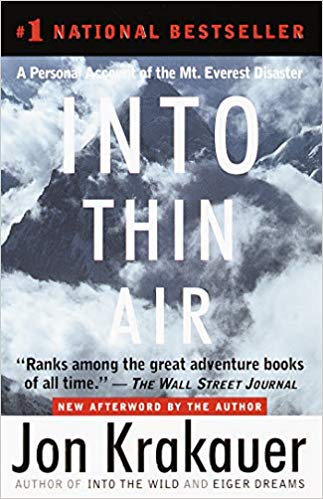
This is the second Jon Krakauer book I have read. The first was Into the Wild. The book details the events leading up to and following the ascent of several climbers up the world’s tallest mountain, Mount Everest, during the Spring of 1996. The author was one of the climbers. He was there to write a piece for Outdoor magazine, which he did, but the events that unfolded went beyond what was expected and a magazine story was not enough to tell the tale. The author paints mountain climbing beyond 20,000 ft as something that is far from enjoyable. Mount Everest is 29,029 ft above sea level. That means that nearly one third of the ascent is packed with misery even under the best of circumstances.
On this particular excursion, an unexpected storm appears just as several climbers are near the peak of Everest. Through misfortune and altitude-clouded judgment, a series of unfortunate events occur that leave climbers scattered over the upper portions of the mountain unable to move, see, or communicate with one another in a blinding snowstorm. In the end, a dozen climbers are lost, including two experienced guides.
I had previously watched the movie Everest, which is based on the same events, but told by a climber named Beck Weathers. Beck is mentioned heavily in the latter portion of Into Thin Air because his particular story is so incredible. Beck was left for dead high up on the mountain, only to show up under his own power at a campsite despite being blinded and having frostbite so bad that parts of both his feet, his hands, and nose had to be amputated. He claimed to have found his way to the campsite, without sight, by following the direction of the wind in an area that had a 7,000 foot drop-off! Could it have been divine intervention that gave him a guiding breeze. Was it just luck? He spent more than 24 hours without shelter in -100° F temperatures with hurricane force winds at an altitude that had 1/3 the oxygen of sea level! Beck, a physician by trade, was a native of Texas, so none of these were conditions he could have been accustomed to. He was left for dead again at the campsite where others put him in a tent with the intention of just trying to keep him comfortable until he passed. He was a frozen zombie that seemingly couldn’t be killed. Beck still practices medicine and still works as a motivational speaker.
The book is very well-written and paints a very grim picture of high-altitude climbing. The movies based on this event leave out much of the ill-effects of altitude climbing. Even under good conditions, people often have difficulty digesting food and sleeping at high altitude. The movies seem to place most of the blame for the misfortune on the storm. It becomes obvious from the information provided by the author that even the most advanced and experienced climbers are compromised both mentally and physically as they get above 20,000 ft. It makes me question why people with a casual interest in climbing the peak are allowed to do so. It appears that anyone with the desire, basic fitness, and $60,000, or so in cash can attempt a guided climb. To me, skydiving seems a far safer and enjoyable experience, but to each, his own, I suppose.
The only knock I have on the book is something that I am not sure could have been mitigated. The author, due to this being a work of non-fiction, includes more characters than is practical for a reader to keep track of. Many are secondary characters to the story, but the author seems to have a fear of leaving anyone out. There are seven main characters, which the film adaptations focus on, but the book contains at least 20 characters. Overall, I highly recommend the book. It does a great job of bringing vivid pictures of high-altitude climbing to the reader without the inherent risks.

